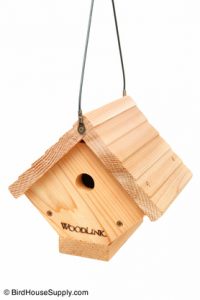If watching birds while sipping your morning coffee is something you enjoy, providing a nesting box in your backyard will help to attract more species to your home. Being aware of what materials and locations work best for Purple Martins versus Wrens, and other species, will help you avoid frustration from an empty nest. Even the entrance hole will affect which types of birds will nest in your new birdhouse.
Birdhouse size matters
Different birds prefer different sizes of nesting boxes to make their homes in. For example, Purple Martins prefer large, apartment –like birdhouses that can be shared with others of their species. In contract, the nocturnal Screech Owl prefers a fairly secluded space all its own. Choosing the right size and shape for your new backyard addition is easy. Just follow these guidelines for the most common types of birds in your area:
Wrens
 Wrens are the easiest birds to attract to a new birdhouse. Carolina and House Wrens both use the same type of habitat. Wren houses should have:
Wrens are the easiest birds to attract to a new birdhouse. Carolina and House Wrens both use the same type of habitat. Wren houses should have:
- A base dimension of 4”x4”x4”
- Be around eight inches high
- Have an entrance hole of about one to two inches that is centered six inches above the floor.
Bluebirds
Eastern, Western and Mountain Bluebirds will all use birdhouses. In most areas of the United States, you’re likely to have a fairly decent population of bluebirds nearby. Bluebird houses should:
- Be approximately 5”x5”x10”
- Have an entrance hole of 1 ½ inches that is centered six inches above the base
- Always be placed in a west-facing direction.
Purple Martins
The apartment-style houses preferred by Purple Martins mean that you should be planning for multiple birds if you want to attract these majestic little creatures. Purple Martins will also nest in houses made out of gourds if you’re feeling industrial and would like to build your own. Purple Martin houses should:
- Have multiple divided areas, each measuring 6”x6”x6”,
- Have a 2 ½ inch hole that is two inches above the floor,
- Always be placed at least 15 feet high and near water.
Wood Ducks
Most ducks do not nest in cavities like the Wood Duck does. In a natural environment, you’re most likely to see the Wood Duck nesting in a tree, but if you have a water source (like a lake or pond) near your yard, they will happily build their nests in a house. Looks for these dimensions and you’ll have ducklings prancing through your yard come late spring:
- Houses should be 10”x10”x24”,
- With a hole that is four inches wide and at least three inches high,
- The elliptical-shaped hole should be centered approximately 20 inches above the floor.
Screech-Owls
Screech-Owls spend a lot more time in your backyard than you might know. Since these are nocturnal birds, you might not notice them if you are not looking. They will nest in the vacant Wood Duck nest over the summer, while the ducks are away. Look for Screech-Owls that are roosting to be sitting in the entrance hole of their nesting box at dusk.
At Birdhousesupply.com, all of our birdhouses have specific dimensions listed to help you pick the right size and shape to fill your yard with birds for years to come.

